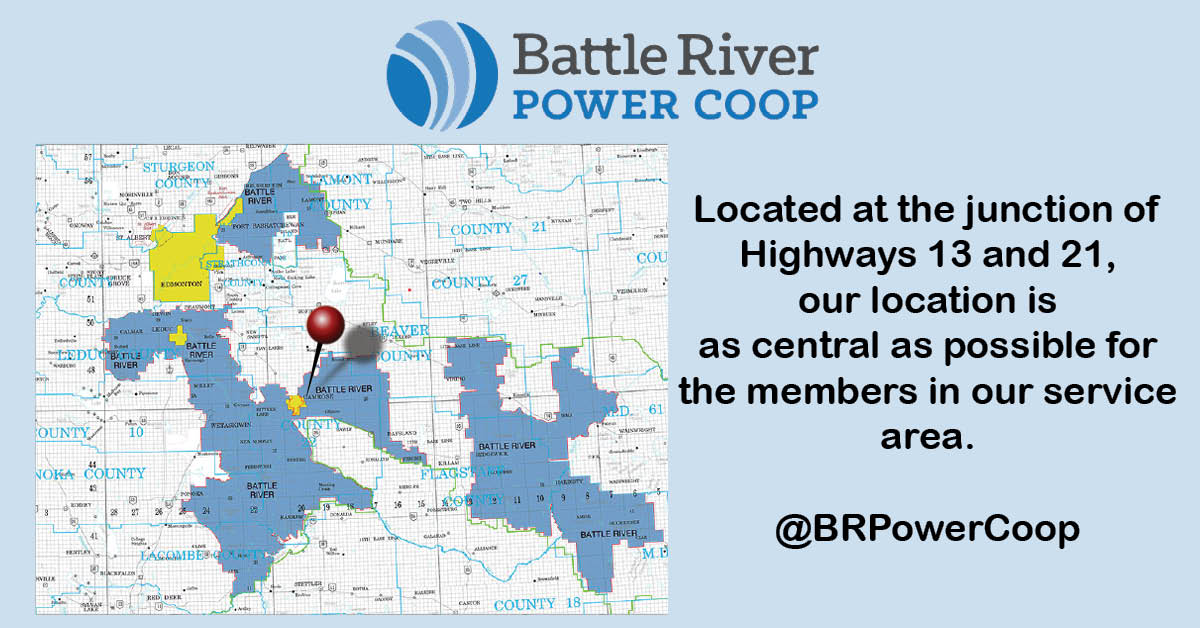Soon after the year 2000, planning began for Battle River Power Coop’s present office and yard. The location is as central as possible for the members in our service area, in the Ervick subdivision near Camrose, at the junction of Highways 13 and 21. It was a progressive move, and made room for increasing staff, equipment, construction materials, and service vehicles.
During this time, repercussions were still being felt from the deregulation of Alberta’s electricity industry, and amalgamations of Rural Electrification Associations (REAs) were in progress. (See Parts 1 and 2 of this series). The most recent amalgamation was in 2006, when Chipman REA, Bruderheim REA and Battle River REA amalgamated, bringing the total number of REAs within Battle River REA to 24.
Originally, each REA held two positions on the Board of Directors, a number that was later reduced to a total of 15. To this day, and to the credit of all those who dedicate their time in service on the Board, Battle River Power Coop has Directors who are well-spaced throughout its service area.
Amalgamation was the first step in becoming self-operational, and far from the last. A sustainable, reliable cost-effective electricity cooperative has many interlocking components, and it is adaptable:
- The coop was, and is now, active in the apprenticeship program for Powerline Technicians (PLTs).
- When Battle River REA began its own Operations Department in 1999, our own PLTs gradually took over the service work formerly done by Investor Owned Utilities, like power restoration, line maintenance and building new services.
- Safety was a priority from the beginning, and qualified presenters have conducted regular safety meetings since 1999. Our scores on Certificate of Recognition (COR) Audits have been the highest in the province for many years running.
- Mapping is essential to all parts of the organization, and hand-drawn mapping was replaced with a more efficient computer system around 2003.
- The Vegetation Management Department was created in 2006.
- Battle River REA was the first in the province to use Automated Meter Reading (AMR), an efficient system that paid for itself in 18 months.
- The System Planning and Engineering Department began in 2016, merging a new engineering component with the former Planning and Design Department.
- In 2015, the Board of Directors decided on a new name, Battle River Power Coop, honouring both our historical and cooperative roots.
- Battle River Power Coop recognizes the advantages of a united voice in industry, regulatory matters, and government relations, and is a long-standing member of the Alberta Federation of REAs (AFREA).
Deregulation of the electricity industry in Alberta in 1996 was the spark that set a new fire blazing in the hearts and minds of REA directors and managers. Many, including those who amalgamated to form Battle River REA, were determined to retain ownership of the electricity cooperatives that their forebears created. Through hard work and dogged perseverance, Battle River REA’s directors, managers and employees created a fully operational electricity distribution utility, second to none and currently the second largest electricity cooperative in Canada. Battle River Power Coop Chair, Dan Astner, describes the process like this: “We started walking, and when the ground was solid under our feet we kept going, and we got to where we are today.”
Acknowledgements: Sincere thanks to those who contributed information for the 3-part series, Battle River Power Coop Celebrates 20 Years of Self-Operations:
Dan Astner: Chair of the Battle River Power Coop Board of Directors; District 3 Representative on the Alberta Federation of REAs Board of Directors
Colleen Musselman, General Manager of Battle River Power Coop from 1999- 2019
Glen Weibelzahl: Mapping Analyst, Journeyman Powerline Technician, and 20-year+ employee at Battle River Power Coop


